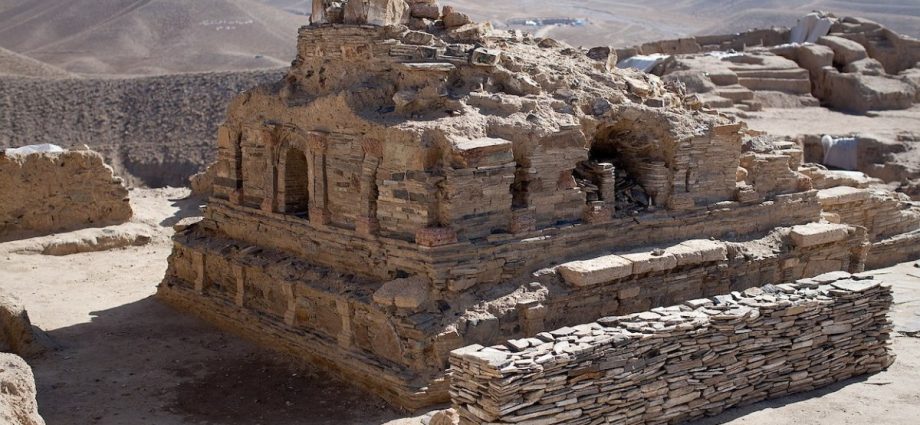
In Kabul’s main bazaar, tucked among the stalls of exposed raw meat, precious pashmina shawls, and cheap electric appliances, are rows of old Japanese porcelain teapots, once broken but painstakingly restored with the skillful use of glue and metal staples.
The artisan in charge of this reconstruction – the patragar – played a significant role in the communities of Central Asia for centuries. Often wandering from bazaar to bazaar, his work (it was almost always a man) involved fixing precious porcelain from China, Japan and Russia, objects of cultural heritage in tea shops along the ancient Silk Road.
But today in Afghanistan, there’s no one to mend the cracked kettles. Like the memories the teapots hold, the patragar himself has been largely lost to history.
In complex socio-political environments, when communities are often torn apart and heritage is alternatively hailed as a beacon of reconciliation or a factor of tension, restoration and reconstruction (or lack thereof) can play a central role in the peace-building process.
Putting pieces of the past back together is not a mundane act. It’s a transformative process as much as a performative one. In his book House of Stone, the late Anthony Shadid takes readers on a material and emotional journey as he finds and rehabilitates his family house in the piedmont of Mount Lebanon.
As he first enters the abandoned courtyards, many questions arise: How to start? Why now? For what purpose? Closely intertwined are doubts about techniques, methods, and temporality.
Shadid’s interrogation echoes a familiar refrain in post-conflict reconstruction. Whom we rebuild for, in what ways, and when, must inform the practice of reconstructing cultural heritage.
Cultural and political conditions typically drive these conversations, but technical queries, like whether to rebuild, are just as important.
In Western traditions of architectural conservation, experts have progressively steered away from reconstructing destroyed heritage, an idea rooted in Western belief that monuments are inherently fixed, constant entities, and that their authenticity lies in their immutability.
In other traditions, where techniques rely, for instance, on wood or earth, architectural shapes are inherently fluid.
In Niger and Mali, for instance, ALIPH Foundation is funding the rehabilitation of major earthen structures (the Tomb of Askia in Gao and the Historic Center of Agadez), which have to undergo constant maintenance. For these projects, restoration is as much a technical process as a social one, which influences when rehabilitation can be done.
Maintenance often constitutes an opportunity for the community to gather and work together. In both countries, this process usually takes place right before the rainy season, early in the spring. But external factors, ranging from conflict to funding availability, have influenced the ability of the communities to carry out some of these projects in their own timeframe.
Indeed, the social impact of a conservation project, and the agency and availability of the local community, are crucial factors to the success of any intervention.
Reconstruction in old Kabul
The organization I work for, the ALIPH Foundation, co-founded by France and the United Arab Emirates in 2017, recently facilitated reconstruction in the Murad Khani district of Kabul’s old city. A lively neighborhood with centuries-old chaykhana (teahouses) and forges, years of conflict had left the area partly collapsed and buried under tons of waste.
With the help of masons from the community, schools were rebuilt and hammams and tea houses re-raised. Reconstruction took place quickly to provide much-needed employment and shelter, according to the community’s own timing.
Elsewhere, time frames are dictated by other factors. South of Kabul at Mes Aynak, one of the most famous Buddhist settlements in the world, ALIPH and our partner, Aga Khan Cultural Services in Afghanistan, are helping to implement an ambitious and incremental conservation plan to guard the site against a potential copper mine.
The goal is to protect the existing structures while identifying and testing longer-term conservation strategies.
The scale of cultural destruction this century – from the Bamiyan Buddhas in Afghanistan and Old Mosul in Iraq, to Palmyra in Syria and Kharkiv in Ukraine – has had disastrous consequences for the world’s tangible and intangible heritage. Be it collateral damage or iconoclastic urges, the international community has been mostly powerless in the face of these brutal attacks.
But inaction sets a dangerous precedent. Restoration and protection of cultural heritage can be instruments for change during conflict. Moreover, cultural heritage needs to be affirmed as a tool for peace. Even as war rages, bridging the diplomatic world and local communities can help form bonds of collaboration that will be needed when the fighting ends.
Some of the region’s traditions may be beyond saving – like the patragars of Kabul. Yet much more is waiting in the wings for the flames of conflict to wane. With the right balance of motivation, timing, technical requirements, and partnerships, and by involving local communities in the work, heritage under fire today can be saved for generations to come.
This article was provided by Syndication Bureau, which holds copyright.

